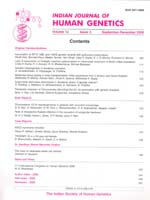
|
Indian Journal of Human Genetics
Medknow Publications on behalf of Indian Society of Human Genetics
ISSN: 0971-6866 EISSN: 1998-362x
Vol. 9, Num. 2, 2003, pp. 39
|
Indian Journal of Human Genetics, Vol. 9, No. 2, July-Dec, 2003, pp. 39
Advances in Genetics: A new direction and distinct medical voice
Dipika Mohanty
Editor, Indian Journal of Human Genetics
Code Number: hg03009
At its most recent meeting, the Editorial Board was pleased to
note the steady increase in quality of manuscripts received and published.
Much remains to be done, however to further increase the impact and distribution
of the journal as well as to attract wide range of scientific and medical communities
interested in various aspects of human genetics. Two major improvements have
recently been made possible, thanks to the constructive support of our publisher
Dr. D. K. Sahu of Medknow Publication. First recent developments of electronic
communication has allowed us to make the articles available on line. In parallel
we have used electronic mail to communicate with authors and reviewers in order
to speed up the publication process. Secondly the appearance of the journal
has been modified with a new internal design. We have given more space to comprehensive
reviews. We hope these changes will improve the visibility of the journal and
serve to distinguish it from other journals in this field. We believe that
Genetics now is a major branch and as such deserves specific treatment. We
hope that with our efforts, together with the active cooperation of the Editorial
Board and Medknow Publication the journal will be more successful infulfilling
the goal. The good news is that this journal has been indexed in CAB Abstracts,
CAB Health, databases of Thomson Gale and EBSCO Publishing, IndMed and Indian
Science Abstracts and is availalbe from Bioline International, Canada (www.bioline.org.br/hg).
It is quite heartening for me to see the spectrum of articles in this issue
covering molecular phylogenetic issues, molecular basis of some inherited disorder
like deafness, polymorphism of vit D receptor gene to population genetics.
It seems Medical Genetics is becoming more
attractive field of research now. One of the article in
this issue by E. Suleymanodlu entitled
"Molecular phylogeneties and functional evolution of major RNA recognition
domains of recently cloned and
characterized autoimmune RNA-Binding particle" is a novel attempt in understanding
the pathophysiology of auto immune disorders. Auto immune response targets a
restricted set of autoantigens. Many of them are nucleic acids and proteins involved
in the synthesis and processing of DNA or RNA. Heterogenous nuclear ribonucleoprotien
(hnRNP) complexes are major constituents of the spliceosome. They are composed
of 30 different proteins which can bind to nascent pre m-RNA. Among these hnRNP-A/B
protein form a subgroup of highly related proteins consisting of two adjacent
RNA binding domains (RBD) within the N-terminal parts,where as the c- terminal
halves contain 50% glycine residues. These proteins in particular
A2/RA33 are targeted by autoantibodies. Since ribonucleoprotein is
one of the most conserved widespread scaffolds, these authors have done the evolutionary
analysis of these RNA binding domains with an idea of getting clue on disease-specific
epitope. They have shown a sequence comparison of RNA-recognition regions of
recently cloned human
hn RNP A3 with those of other relevant hnRNP A/B-type proteins (xenopus
laevis
hnRNPA3 and FBRNP). They proposed that the overall folding pattern
of these domains and the protein antigenicity arising from this is the determining
factor to be differentially recognised by the autoantibodies. However, more mutational
analysis combined with thermodynamic, kinetic, structural and evolutionary computation
data is needed to understand the pathophysiology of a complex disorder like autoimmune
disease.
Copyright 2003 - the Indian Society of Human Genetics
|
